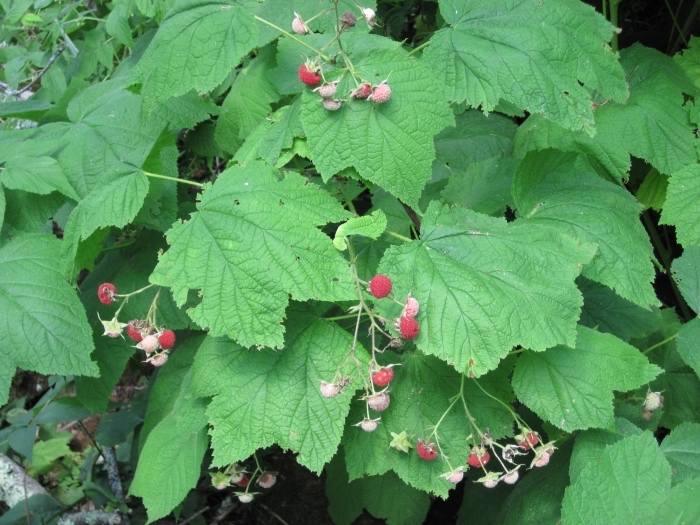Thimbleberry
(Rubus parviflorus)
Thimbleberry (Rubus parviflorus)
/
/

Kristof Zyskowski & Yulia Bereshpolova
CC BY 2.0
Image By:
Kristof Zyskowski & Yulia Bereshpolova
Recorded By:
Copyright:
CC BY 2.0
Copyright Notice:
Photo by: Kristof Zyskowski & Yulia Bereshpolova | License Type: CC BY 2.0 | License URL: https://creativecommons.org/licenses/by/2.0 | Uploader: Ser Amantio di Nicolao | Publisher: Wikimedia Commons | Title: Rosaceae-_Rubus_parviflorus_(Thimbleberry).jpg | Notes: User created page with UploadWizard |

















































Estimated Native Range
Summary
Rubus parviflorus, commonly known as Thimbleberry, is a deciduous shrub native to moist forests, forest edges, and clearings of western North America, from Alaska to California and eastward to the Rocky Mountains and the Great Lakes Region. It thrives in a variety of habitats, including roadsides and areas recovering from disturbance such as forest fires. This plant typically grows up to 2.5 meters (8 feet) tall and spreads through underground rhizomes, forming dense clumps. Thimbleberry is notable for its large, hairy, palmate leaves that can reach up to 20 cm (8 inches) across, with five lobes and a soft, fuzzy texture. It is thornless, distinguishing it from many other Rubus species.
The white flowers of Thimbleberry are among the largest in the genus, measuring 2 to 6 cm (3/4 to 2+1/4 inches) in diameter, with five petals and numerous pale yellow stamens, blooming from late spring to early summer. The flowers are highly attractive to pollinators such as native bees, honeybees, and bumblebees. Following flowering, the plant produces edible composite fruit about 1 cm (1/2 inch) in diameter, ripening to a bright red in mid to late summer. The fruit is enjoyed by various birds and mammals, including bears, and is a larval host and nectar source for the yellow-banded sphinx moth. Thimbleberry is valued for its ease of maintenance, attractive foliage, and showy flowers, making it suitable for naturalistic plantings and wildlife gardens. It prefers partial shade to full sun, moist well-drained soils, and is tolerant of a range of soil conditions. While not commercially developed for fruit production, its berries are edible and can be used in jams and desserts.CC BY-SA 4.0
The white flowers of Thimbleberry are among the largest in the genus, measuring 2 to 6 cm (3/4 to 2+1/4 inches) in diameter, with five petals and numerous pale yellow stamens, blooming from late spring to early summer. The flowers are highly attractive to pollinators such as native bees, honeybees, and bumblebees. Following flowering, the plant produces edible composite fruit about 1 cm (1/2 inch) in diameter, ripening to a bright red in mid to late summer. The fruit is enjoyed by various birds and mammals, including bears, and is a larval host and nectar source for the yellow-banded sphinx moth. Thimbleberry is valued for its ease of maintenance, attractive foliage, and showy flowers, making it suitable for naturalistic plantings and wildlife gardens. It prefers partial shade to full sun, moist well-drained soils, and is tolerant of a range of soil conditions. While not commercially developed for fruit production, its berries are edible and can be used in jams and desserts.CC BY-SA 4.0
Plant Description
- Plant Type: Shrub
- Height: 4-8 feet
- Width: 4-8 feet
- Growth Rate: Moderate
- Flower Color: White
- Flowering Season: Spring, Summer
- Leaf Retention: Deciduous
Growth Requirements
- Sun: Full Sun, Part Shade
- Water: Medium
- Drainage: Medium
Common Uses
Bee Garden, Bird Garden, Butterfly Garden, Edible*Disclaimer: Easyscape's listed plant edibility is for informational use. Always verify the safety and proper identification of any plant before consumption., Erosion Control, Fire Resistant, Fragrant, Hummingbird Garden, Showy Flowers
Natural Habitat
Moist forests, forest edges, and clearings in western North America
Other Names
Common Names: Redcaps
Scientific Names: Rubus parviflorus , Rubus nutkanus var. parviflorus , Rubus ribifolius , Rubus natkanus
GBIF Accepted Name: Rubus parviflorus Figert ex Sprib.